Structural and Dimensional Analysis by Computed Tomography of a Multi Geometric Template Manufactured by Fused Deposition Modeling
Abstract
:1. Introduction
1.1. Manufacturing
1.2. Additive Manufacturing
1.3. Fused Filament Manufacturing
1.4. Optimization Algorithm
1.5. Computed Tomography
2. Materials and Methods
- Multi-geometric component: The template presented by Aguilar-Duque et al. [76]. The modifications consisted of the redistribution of the geometric elements and the integration of two threaded cylindrical elements.
- Printing of the multi-geometric component: The printing process of the control template and the template with the modified path process was carried out using an Ultimaker S5 printer. Considering the recommendations of the parameters identified in the literature review, the printing equipment was prepared according to the parameters shown in Table 3.
- 4.
- Measurement of components: The components were measured using VG Studio software for porosity analyses, and Geomagic was used for dimensional analyses. Using a point cloud of the workpiece, the geometric shapes were created, and the edges of the elements were always avoided in order to avert the influence of possible imperfections. Each component was measured according to the reference coordinates. The comparative analysis considers the characteristics of interest, which are presented in Table 5.
- 5.
- Comparison of nominal versus actual CAD: From the dimensions specified in the design, the error generated by the fused filament printing process is determined via tomographic analysis:
- 6.
- Comparison with the image.
- 7.
- Error calculation.
- 8.
- Classification of geometry deviations in ranges of units.
- 9.
- Classify the issue of nominal and real volumes considering the internal characteristics.
3. Results
3.1. Reduction in Manufacturing Time via GA
3.2. Computed Tomography
3.3. Dimensional Analysis
3.4. Structural Analysis
4. Discussion
5. Conclusions
Author Contributions
Funding
Data Availability Statement
Conflicts of Interest
References
- Kajwang, B. Global challenges and their role in talent management crisis facing insurance industry. Int. J. Sust. Strateg. 2022, 7, 1–10. [Google Scholar] [CrossRef]
- Kehayov, M.; Holder, L.; Koch, V. Application of artificial intelligence technology in the manufacturing process and purchasing and supply management. Procedia Comp. Sci. 2022, 200, 1209–1217. [Google Scholar] [CrossRef]
- Global Manufacturing Output Growth Reaches 3.9 for 2022. Available online: https://www.automation.com/en-us/articles/september-2022/global-manufacturing-output-growth-2022 (accessed on 12 June 2022).
- Ayubjono’gli, A.A. Principles of Financial Innovation. Acad. Res. 2022, 4, 70–73. [Google Scholar]
- Gazzola, P.; Pavione, E.; Pezzetti, R.; Grechi, D. Trends in the fashion industry. The perception of sustainability and circular economy: A gender/generation quantitative approach. Sustainability 2020, 12, 2809. [Google Scholar] [CrossRef]
- Omonov, F.; Dehqonov, Q. Electric Cars as the Cars of the Future. Eurasian J. Eng. Technol. 2022, 4, 128–133. [Google Scholar]
- Kalpakjian, S.; Schmid, S.R. Manufacturing, Engineering and Technology [In Spanish: Manufactura, Ingeniería y Tecnología], 7th ed.; Pearson Educación: Hoboken, NJ, USA, 2014. [Google Scholar]
- Intelligence, M. Additive Manufacturing & Materials Market—Growth, Trends, and Forecast (2020–2025). Available online: https://www.mordorintelligence.com/industry-reports/global-additive-manufacturing-and-material-market-industry (accessed on 13 April 2020).
- Sonar, H.C.; Khanzode, V.; Akarte, M. A conceptual framework on implementing additive manufacturing technology towards firm competitiveness. Int. J. Glob. Bus. Compet. 2020, 15, 121–135. [Google Scholar] [CrossRef]
- Businesswire. Global Smart Factory Market Research Report 2022–2027: Analysys of SCADA, PM, MES, Industrial Safety, Industrial Sensors, Industrial Robots, Industrial 3d Printers, Machine Vision Systems. Available online: https://www.businesswire.com/news/home/20221205005517/en/Global-Smart-Factory-Market-Research-Report-2022-2027-Analysis-of-SCADA-PAM-MES-Industrial-Safety-Industrial-Sensors-Industrial-Robots-Industrial-3D-Printers-Machine-Vision-Systems---ResearchAndMarkets.com (accessed on 12 June 2022).
- ASTM F2921-11; Standard Terminology for Additive Manufacturing—Coordinate Systems and Test Methodologies. ASTM International: West Conshohocken, PA, USA, 2013.
- Deswal, S.; Narang, R.; Chhabra, D. Modeling and parametric optimization of FDM 3D printing process using hybrid techniques for enhancing dimensional preciseness. Int. J. Interact. Des. Manuf. 2019, 13, 1197–1214. [Google Scholar] [CrossRef]
- Economics, O. The Future of Global Manufacturing; Oxford Economics: Oxford, UK, 2019; p. 46. [Google Scholar]
- Tanenbaum, M.; Holstein, W. Mass Production. Available online: https://www.britannica.com/technology/mass-production (accessed on 15 April 2019).
- Srivatsan, T.S.; Sudarchan, T.S. Additive Manufacturing. Innovations, Advances, and Applications, 1st ed.; Taylor & Francis: Boca Raton, FL, USA, 2016; Volume 1, p. 444. [Google Scholar]
- Bourell, D.; Beaman, J.J.; Marcurs, H.L.; Barlow, J.W. Solid Freform Fabrication an Advanced Manufacturing Approach. In Proceedings of the International Solid Freeform Fabrication Symposium, Austin, TX, USA, 6–8 August 1990; p. 7. [Google Scholar]
- Campbell, I.; Bourell, D.; Gibson, I. Additive manufacturing: Rapid prototyping comes of age. Rapid Prototyp. J. 2012, 18, 255–258. [Google Scholar] [CrossRef]
- ASTM F2792-12a; Standard Terminology for Additive Manufacturing Technologies. ASTM International: West Conshohocken, PA, USA, 2013. [CrossRef]
- Nikitakos, N.; Dagkinis, I.; Papachristos, D.; Georgantis, G.; Kostidi, E. Economics in 3D printing. In 3D Printing: Applications in Medicine and Surgery; Elsevier Inc.: Amsterdam, The Netherlands, 2020; pp. 85–95. [Google Scholar]
- Pazhamannil, R.V.; Vn, J.N.; Govindan, P.; Edacherian, A. Property enhancement approaches of fused filament fabrication technology: A review. Polym. Eng. Sci. 2022, 5, 1356–1376. [Google Scholar] [CrossRef]
- Dua, R.; Rashad, Z.; Spears, J.; Dunn, G.; Maxwell, M. Applications of 3d-printed peek via fused filament fabrication: A systematic review. Polymers 2021, 22, 4046. [Google Scholar] [CrossRef]
- Singh, P.; Balla, V.K.; Atre, S.V.; German, R.M.; Kate, K.H. Factors affecting properties of Ti-6Al-4V alloy additive manufactured by metal fused filament fabrication. Powder Technol. 2022, 386, 9–19. [Google Scholar] [CrossRef]
- Fico, D.; Rizzo, D.; Casciaro, R.; Esposito Corcione, C. A review of polymer-based materials for fused filament fabrication (FFF): Focus on sustainability and recycled materials. Polymers 2022, 14, 465. [Google Scholar] [CrossRef] [PubMed]
- Giorleo, L.; Ceretti, E. Deep drawing punches produced using fused filament fabrication technology: Performance evaluation. J. Manuf. Process. 2022, 84, 1–9. [Google Scholar] [CrossRef]
- Jahromi, F.T.; Nikzad, M.; Prasad, K.; Norén, J.; Isaksson, M.; Arian, A.; Sbarski, I. Additive manufacturing of polypropylene micro and nano composites through fused filament fabrication for automotive repair applications. Polym. Adv. Technol. 2023, 34, 1059–1074. [Google Scholar] [CrossRef]
- Choudhary, N.; Sharma, V.; Kumar, P. Polylactic acid-based composite using fused filament fabrication: Process optimization and biomedical application. Polym. Compos. 2023, 44, 69–88. [Google Scholar] [CrossRef]
- Ekinci, A.; Gleadall, A.; Johnson, A.A.; Li, L.; Han, X. Mechanical and hydrolytic properties of thin polylactic acid films by fused filament fabrication. J. Mech. Behav. Biomed. Mater. 2021, 114, 104217. [Google Scholar] [CrossRef]
- Vindokurov, I.; Pirogova, Y.; Tashkinov, M.; and Silberschmidt, V.V. Effect of Heat Treatment on Elastic Properties and Fracture Toughness of Fused Filament Fabricated PEEK for Biomedical Applications. Polymers 2022, 14, 5521. [Google Scholar] [CrossRef]
- He, C.-H.; Liu, S.-H.; Liu, C.; Mohammad-Sedighi, H. A novel bond stress-slip model for 3-D printed concretes. Discrete Contin. Dyn. Syst. 2022, 15, 1669–1683. [Google Scholar] [CrossRef]
- He, C.-H.; Liu, C. Fractal approach to the fluidity of a cement mortar. Nonlinear Eng. 2022, 11, 1–5. [Google Scholar] [CrossRef]
- Yadav, A.; Rohru, P.; Babbar, A.; Kumar, R.; Ranjan, N.; Singh Chohan, J.; Kumar, R.; Gupta, M. Fused filament fabrication: A state-of-the-art review of the technology, materials, properties and defects. Int. J. Interact. Des. Manuf. 2022, 1–23. [Google Scholar] [CrossRef]
- Tosto, C.; Tirillò, J.; Sarasini, F.; Cicala, G. Hybrid metal/polymer filaments for fused filament fabrication (FFF) to print metal parts. Appl. Sci. 2021, 11, 1444. [Google Scholar] [CrossRef]
- Guo, Q.; Zhao, C.; Qu, M.; Xiong, L.; Escano, L.; Mohammad, S.; Hojjatzadeh, H.; Niranjan, D.P.; Fezzaa, K.; Everhart, W.; et al. In-situ characterization and quantification of melt pool variation under constant input energy density in laser powder bed fusion additive manufacturing process. Addit. Manuf. 2019, 28, 600–609. [Google Scholar] [CrossRef]
- Wang, Y.; Guo, W.; Xie, Y.; Li, H.; Zeng, C.; Xu, M.; Zhang, H. In-situ monitoring plume, spattering behavior and revealing their relationship with melt flow in laser powder bed fusion of nickel-based superalloy. J. Mater. Sci. Technol. 2023, in press. [Google Scholar] [CrossRef]
- Sinclair, L.; Leung, C.L.A.; Marussi, S.; Clarck, S.J.; Chen, Y.; Olbinado, M.P.; Rack, A.; Gardy, J.; Baxter, G.; Lee, P.D. In situ radiographic and ex situ tomographic analysis of pore interactions during multilayer builds in laser powder bed fusion. Addit. Manuf. 2020, 36, 101512. [Google Scholar] [CrossRef]
- Zuo, Y.; Liu, H. Is the spider a weaving master or a printing expert? Therm. Sci. 2022, 26, 2471–2475. [Google Scholar] [CrossRef]
- Taha, M.M.; Jumaidin, R.; Razali, N.; Kudus, S.I.A. Green Material for Fused Filament Fabrication. In Implementation and Evaluation of Green Materials in Technology Development: Emerging Research and Opportunities; Mastura, M.T., Sapuan, S.M., Eds.; IGI Global: Hershey, PA, USA, 2020; pp. 1–27. [Google Scholar]
- Lüchtenborg, J.; Burkhardt, F.; Nold, J.; Rothlauf, S.; Wesemann, C.; Pieralli, S.; Wemken, G.; Witkowski, S.; Spies, B.C. Implementation of Fused Filament Fabrication in Dentistry. Appl. Sci. 2021, 11, 6444. [Google Scholar] [CrossRef]
- Ganetsos, T.; Kantaros, A.; Gioldasis, N.; Brachos, K. Applications of 3D Printing and Illustration in Industry. In Proceedings of the 2023 17th International Conference on Engineering of Modern Electric Systems (EMES), Oradea, Romania, 9–10 June 2023; pp. 1–4. [Google Scholar]
- AbouelNour, Y.; Gupta, N. In-situ monitoring of sub-surface and internal defects in additive manufacturing: A review. Mater. Des. 2022, 222, 111063. [Google Scholar] [CrossRef]
- Brennan, M.; Keist, J.; Palmer, T. Defects in metal additive manufacturing processes. J. Mater. Eng. Perform. 2021, 30, 4808–4818. [Google Scholar] [CrossRef]
- Wu, B.; Pan, Z.; Ding, D.; Cuiuri, D.; Li, H.; Xu, J.; Norrish, J. A review of the wire arc additive manufacturing of metals: Properties, defects and quality improvement. J. Manuf. Process 2018, 35, 127–139. [Google Scholar] [CrossRef]
- Crump, S.S. Apparatus and Method for Creating Three-Dimensional Objects. U.S. Patent 5121329A, 9 June 1992. [Google Scholar]
- Market Data Forecast. 3D Printing Market. 2022–2027. Available online: https://www.marketdataforecast.com/ (accessed on 22 December 2022).
- Singh, K. Experimental study to prevent the warping of 3D models in fused deposition modeling. Int. J. Plast. Technol. 2018, 22, 177–184. [Google Scholar] [CrossRef]
- Xie, J.; Saluja, A.; Rahimizadeh, A.; Fayazbakhsh, K. Development of automated feature extraction and convolutional neural network optimization for real-time warping monitoring in 3D printing. Int. J. Comput. Integr. Manuf. 2022, 35, 813–830. [Google Scholar] [CrossRef]
- Paraskevoudis, K.; Karayannis, P.; Koumoulos, E.P. Real-time 3D printing remote defect detection (stringing) with computer vision and artificial intelligence. Processes 2020, 8, 1464. [Google Scholar] [CrossRef]
- Liao, J.; Shen, Z.; Xiong, G.; Liu, C.; Luo, C.; Lu, J. Preliminary study on fault diagnosis and intelligent learning of fused deposition modeling (FDM) 3D Printer. In Proceedings of the 2019 14th IEEE Conference on Industrial Electronics and Applications (ICIEA), Xi’an, China, 19–21 June 2019; pp. 2098–2102. [Google Scholar]
- Milovanović, A.; Milošević, M.; Mladenović, G.; Likozar, B.; Čolić, K.; Mitrović, N. Experimental dimensional accuracy analysis of reformer prototype model produced by FDM and SLA 3D printing technology. In Experimental and Numerical Investigations in Materials Science and Engineering; Springer: Berlin/Heidelberg, Germany, 2018; pp. 84–95. [Google Scholar]
- Zagidullin, R.; Zezin, N.; Rodionov, N. Improving the quality of FDM 3D printing of UAV and aircraft parts and assemblies by parametric software changes. In IOP Conference Series: Materials Science and Engineering; IOP Publishing: Bristol, UK, 2021; p. 012031. [Google Scholar]
- Ferretti, P.; Leon-Cardenas, C.; Santi, G.M.; Sali, M.; Ciotti, E.; Frizziero, L.; Donnici, G.; Liverani, A. Relationship between fdm 3d printing parameters study: Parameter optimization for lower defects. Polymers 2021, 13, 2190. [Google Scholar] [CrossRef] [PubMed]
- Wickramasinghe, S.; Do, T.; Tran, P. FDM-based 3D printing of polymer and associated composite: A review on mechanical properties, defects and treatments. Polymers 2020, 12, 1529. [Google Scholar] [CrossRef] [PubMed]
- Dey, A.; Yodo, N. A systematic survey of FDM process parameter optimization and their influence on part characteristics. J. Manuf. Mater. Process 2019, 3, 64. [Google Scholar] [CrossRef]
- Sheoran, A.J.; Kumar, H. Fused Deposition modeling process parameters optimization and effect on mechanical properties and part quality: Review and reflection on present research. Mater. Today Proc. 2020, 21, 1659–1672. [Google Scholar] [CrossRef]
- Chen, C.-J.; Tseng, C.-S. The path and location planning of workpieces by genetic algorithms. J. Intell. Manuf. 1996, 7, 69–76. [Google Scholar] [CrossRef]
- Castelino, K.; D’Souza, R.; Wright, P.K. Toolpath optimization for minimizing airtime during machining. J. Manuf. Syst. 2003, 22, 173–180. [Google Scholar] [CrossRef]
- Agrawal, R.K.; Pratihar, D.; Choudhury, A.R. Optimization of CNC isoscallop free form surface machining using a genetic algorithm. Int. J. Mach. Tools Manuf. 2006, 46, 811–819. [Google Scholar] [CrossRef]
- Palanisamy, P.; Rajendran, I.; Shanmugasundaram, S. Optimization of machining parameters using genetic algorithm and experimental validation for end-milling operations. Int. J. Adv. Manuf. Tech. 2007, 32, 644–655. [Google Scholar] [CrossRef]
- Yodo, N.; Dey, A. Multi-objective optimization for FDM process parameters with evolutionary algorithms. In Fused Deposition Modeling Based 3D Printing; Springer: Cham, Switzerland, 2021; pp. 419–444. [Google Scholar]
- Deshwal, S.; Kumar, A.; Chhabra, D. Exercising hybrid statistical tools GA-RSM, GA-ANN and GA-ANFIS to optimize FDM process parameters for tensile strength improvement. CIRP J. Manuf. Sci. Technol. 2020, 31, 189–199. [Google Scholar] [CrossRef]
- Raju, M.; Gupta, M.K.; Bhanot, N.; Sharma, V.S. A hybrid PSO–BFO evolutionary algorithm for optimization of fused deposition modelling process parameters. J. Intell. Manuf. 2019, 30, 2743–2758. [Google Scholar] [CrossRef]
- Cus, F.; Balic, J.; Zuperl, U. Hybrid ANFIS-ants system based optimisation of turning parameters. J. Achiev. Mater. Manuf. Eng. 2009, 36, 79–86. [Google Scholar]
- Oysu, C.; Bingul, Z. Tool Path Optimization Using Genetic Algorithms. In Proceedings of the GEM, Las Vegas, NV, USA, 25–28 June 2007; pp. 120–126. [Google Scholar]
- Ülker, E.; Turanalp, M.E.; Halkaci, H.S. An artificial immune system approach to CNC tool path generation. J. Intell. Manuf. 2009, 20, 67–77. [Google Scholar] [CrossRef]
- Nguyen, V.; Huynh, T.; Nguyen, T.; Tran, T. Single and Multi-objective Optimization of Processing Parameters for Fused Deposition Modeling in 3D Printing Technology. Int. J. Automot. Mech. Eng. 2020, 17, 7542–7551. [Google Scholar] [CrossRef]
- Ontiveros, S.; Jiménez, R.; Yagüe-Fabra, J.A.; Torralba, M. Analysis of Surface Extraction Methods Based on Gradient Operators for Computed Tomography in Metrology Applications. Materials 2018, 11, 1461. [Google Scholar] [CrossRef]
- Villarraga-Gómez, H.; Lee, C.; Smith, S.T. Dimensional metrology with X-ray CT: A comparison with CMM measurements on internal features and compliant structures. Precis. Eng. 2018, 51, 291–307. [Google Scholar] [CrossRef]
- De Chiffre, L.; Carmignato, S.; Kruth, J.P.; Schmitt, R.; Weckenmann, A. Industrial applications of computed tomography. CIRP Annals 2014, 63, 655–677. [Google Scholar] [CrossRef]
- Khosravani, M.R.; Reinicke, T. On the Use of X-ray Computed Tomography in Assessment of 3D-Printed Components. J. Nondest. Eval. 2020, 39, 75. [Google Scholar] [CrossRef]
- Cho, S.-Y.; Lee, J.-R. Investigation of manufacturing defects in 3D-printed CFRP using laser ultrasonic testing and x-ray micro-computed tomography. Funct. Compos. Struct. 2021, 3, 025005. [Google Scholar] [CrossRef]
- Cox, S.C.; Thornby, J.A.; Gibbons, G.J.; Williams, M.A.; Mallick, K.K. 3D printing of porous hydroxyapatite scaffolds intended for use in bone tissue engineering applications. Mater. Sci. Eng. C 2015, 47, 237–247. [Google Scholar] [CrossRef] [PubMed]
- Dorokhov, V.; Ovsienko, O.; Chugunov, S.; Rogozina, M.; Anikeev, N.; Nikulshin, P. Filtration Performance of 3D-Printed Ceramic Pellets: Investigation Using CFD and Computed Tomography. Pet. Chem. 2023, 63, 437–442. [Google Scholar] [CrossRef]
- Thompson, A.; Maskery, I.; Leach, R.K. X-ray computed tomography for additive manufacturing: A review. Meas. Sci. Tech. 2016, 27, 072001. [Google Scholar] [CrossRef]
- Tkac, J.; Toth, T.; Molnar, V.; Dovica, M.; Fedorko, G. Possibilities of analysis of porous structures using industrial computed tomography. Eng. Fail. Anal. 2022, 137, 106296. [Google Scholar] [CrossRef]
- Tkac, J.; Toth, T.; Molnar, V.; Dovica, M.; Fedorko, G. Observation of porous Structure’s deformation wear after axial loading with the use of Industrial computed tomography (CT). Measurement 2022, 200, 111631. [Google Scholar] [CrossRef]
- Aguilar-Duque, J.I.; Balderrama-Armendáriz, C.O.; Puente-Montejano, C.A.; Ontiveros-Zepeda, A.S.; García-Alcaraz, J.L. Genetic algorithm for the reduction printing time and dimensional precision improvement on 3D components printed by fused filament fabrication. Int. J. Adv. Manuf. Tech. 2021, 115, 3965–3981. [Google Scholar] [CrossRef]
- Solomon, I.J.; Sevvel, P.; Gunasekaran, J. A review on the various processing parameters in FDM. Mater. Today Proc. 2021, 37, 509–514. [Google Scholar] [CrossRef]
- Ahn, D.; Kim, H.; Lee, S. Fabrication direction optimization to minimize post-machining in layered manufacturing. Int. J. Mach. Tools Manuf. 2007, 47, 593–606. [Google Scholar] [CrossRef]
- Mohamed, O.A.; Masood, S.H.; Bhowmik, J.L. Optimization of fused deposition modeling process parameters: A review of current research and future prospects. Adv. Manuf. 2015, 3, 42–53. [Google Scholar] [CrossRef]
- Sood, A.K.; Ohdar, R.K.; Mahapatra, S.S. Improving dimensional accuracy of Fused Deposition Modelling processed part using grey Taguchi method. Mater. Des. 2009, 30, 4243–4252. [Google Scholar] [CrossRef]
- Srivastava, P.R. A cooperative approach to optimize the Printed Circuit Boards drill routing process using Intelligent Water Drops. Comp. Electr. Eng. 2015, 43, 270–277. [Google Scholar] [CrossRef]
- Letcher, T.; Waytashek, M. Material Property Testing of 3D-Printed Specimen in PLA on an Entry-Level 3D Printer. In Proceedings of the ASME International Mechanical Engineering Congress and Exposition, Montreal, QC, Canada, 14–20 November 2014. [Google Scholar]
- Qattawi, A.; Alrawi, B.; Guzman, A. Experimental optimization of fused deposition modelling processing parameters: A design-for-manufacturing approach. Procedia Manuf. 2017, 10, 791–803. [Google Scholar] [CrossRef]
- Kovan, V.; Altan, G.; Topal, E.S. Effect of layer thickness and print orientation on strength of 3D printed and adhesively bonded single lap joints. J. Mech. Sci. Tech. 2017, 31, 2197–2201. [Google Scholar] [CrossRef]
- Agarwala, M.K.; Jamalabad, V.R.; Langrana, N.A.; Safari, A.; Whalen, P.J.; Danforth, S.C. Structural quality of parts processed by fused deposition. Rapid Prototyp. J. 1996, 2, 4–19. [Google Scholar] [CrossRef]
- Weeren, R.V.; Agarwala, M.; Jamalabad, V.; Bandyopadhyay, A.; Vaidyanathan, R.; Langrana, N.; Safari, A.; Whalen, P.; Danforth, S.; Ballard, C. Quality of parts processed by fused deposition. In Proceedings of the 1995 International Solid Freeform Fabrication Symposium, Austin, TX, USA, 7–9 August 1995. [Google Scholar]
- Barletta, M.; Gisario, A.; Mehrpouya, M. 4D printing of shape memory polylactic acid (PLA) components: Investigating the role of the operational parameters in fused deposition modelling (FDM). J. Manuf. Process 2021, 61, 473–480. [Google Scholar] [CrossRef]
- Khan, S.; Joshi, K.; Deshmukh, S. A comprehensive review on effect of printing parameters on mechanical properties of FDM printed parts. Mater. Today Proc. 2022, 50, 2119–2127. [Google Scholar] [CrossRef]
- Valerga, A.P.; Batista, M.; Salguero, J.; Girot, F. Influence of PLA filament conditions on characteristics of FDM parts. Materials 2018, 11, 1322. [Google Scholar] [CrossRef]
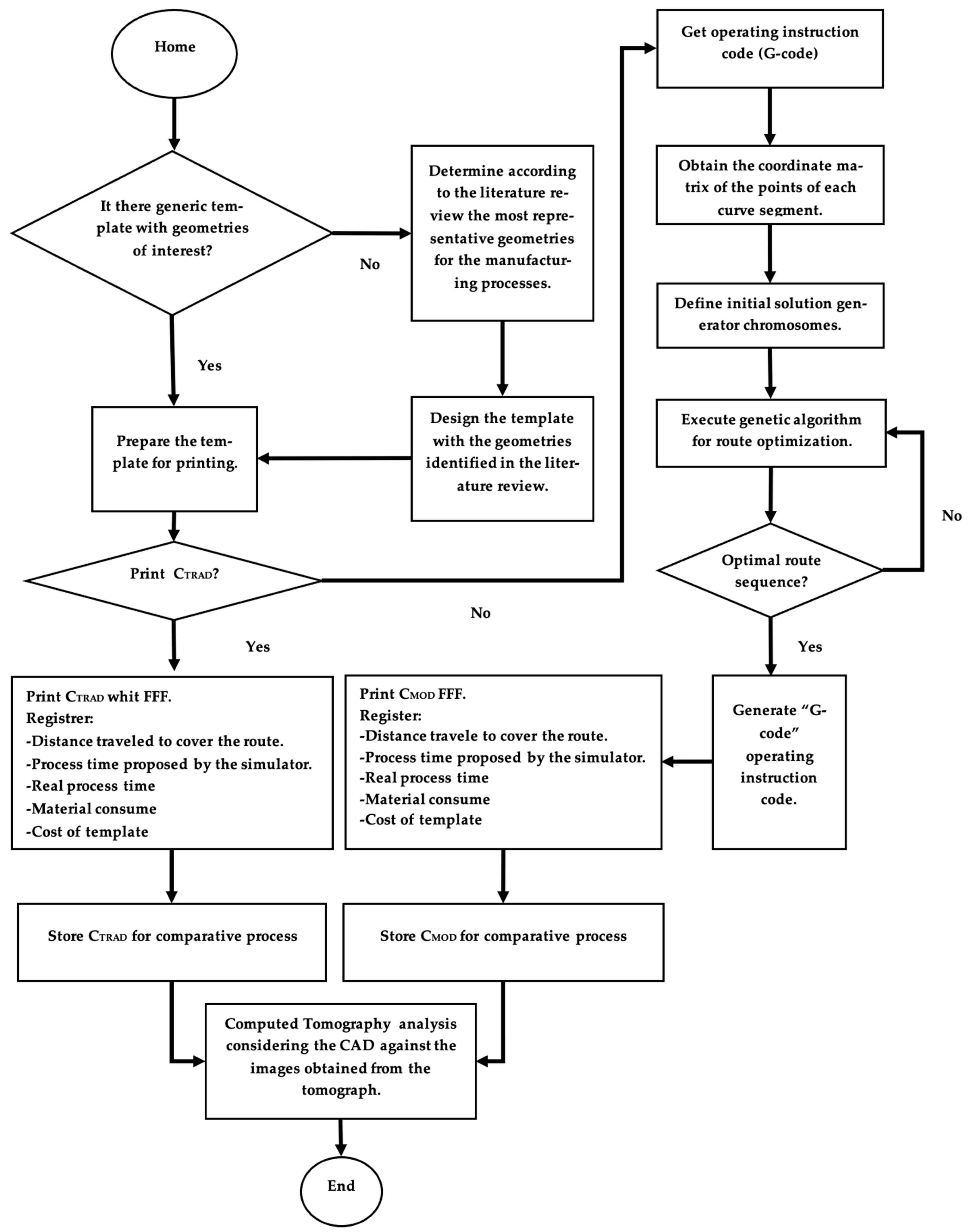
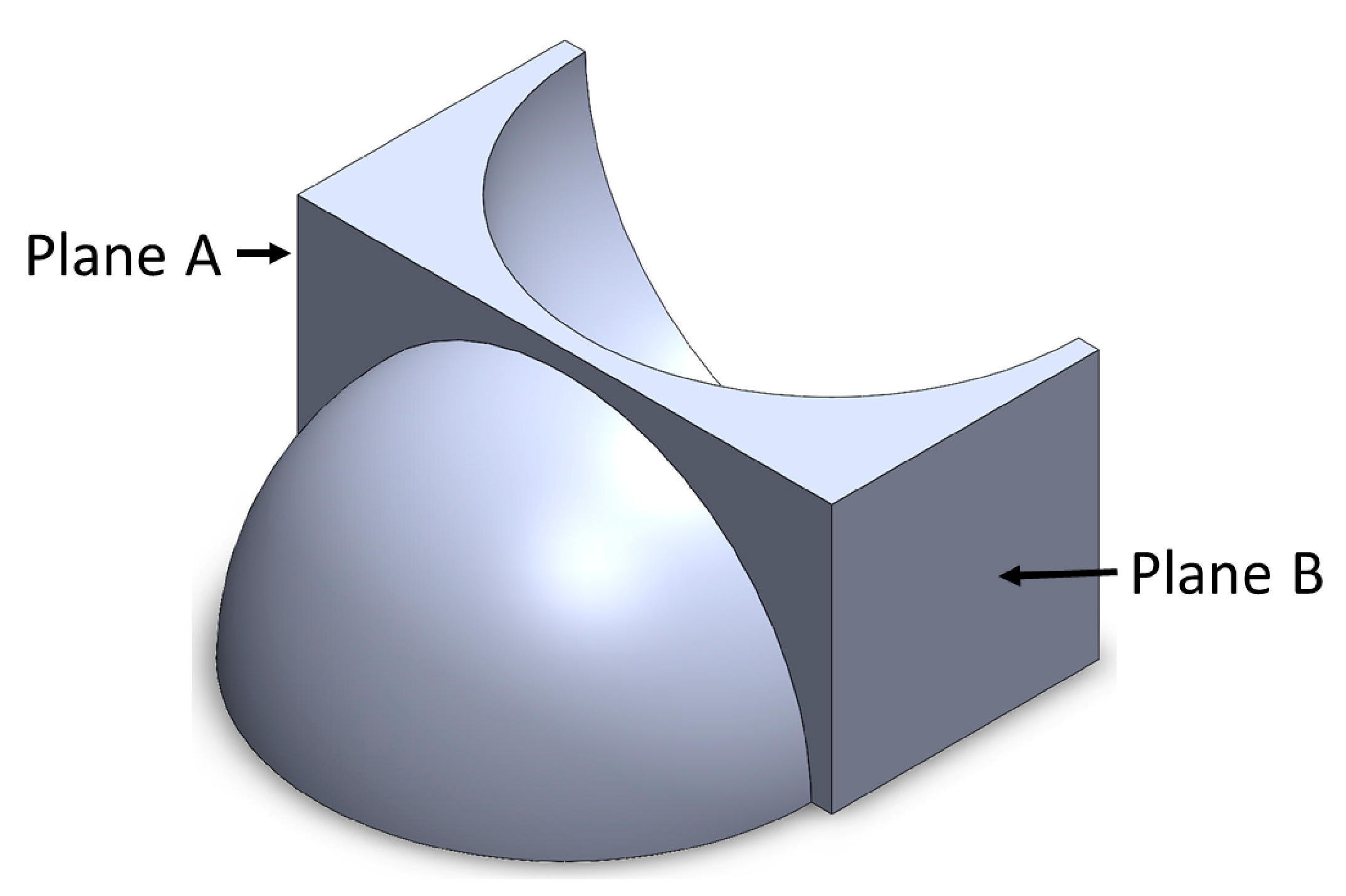

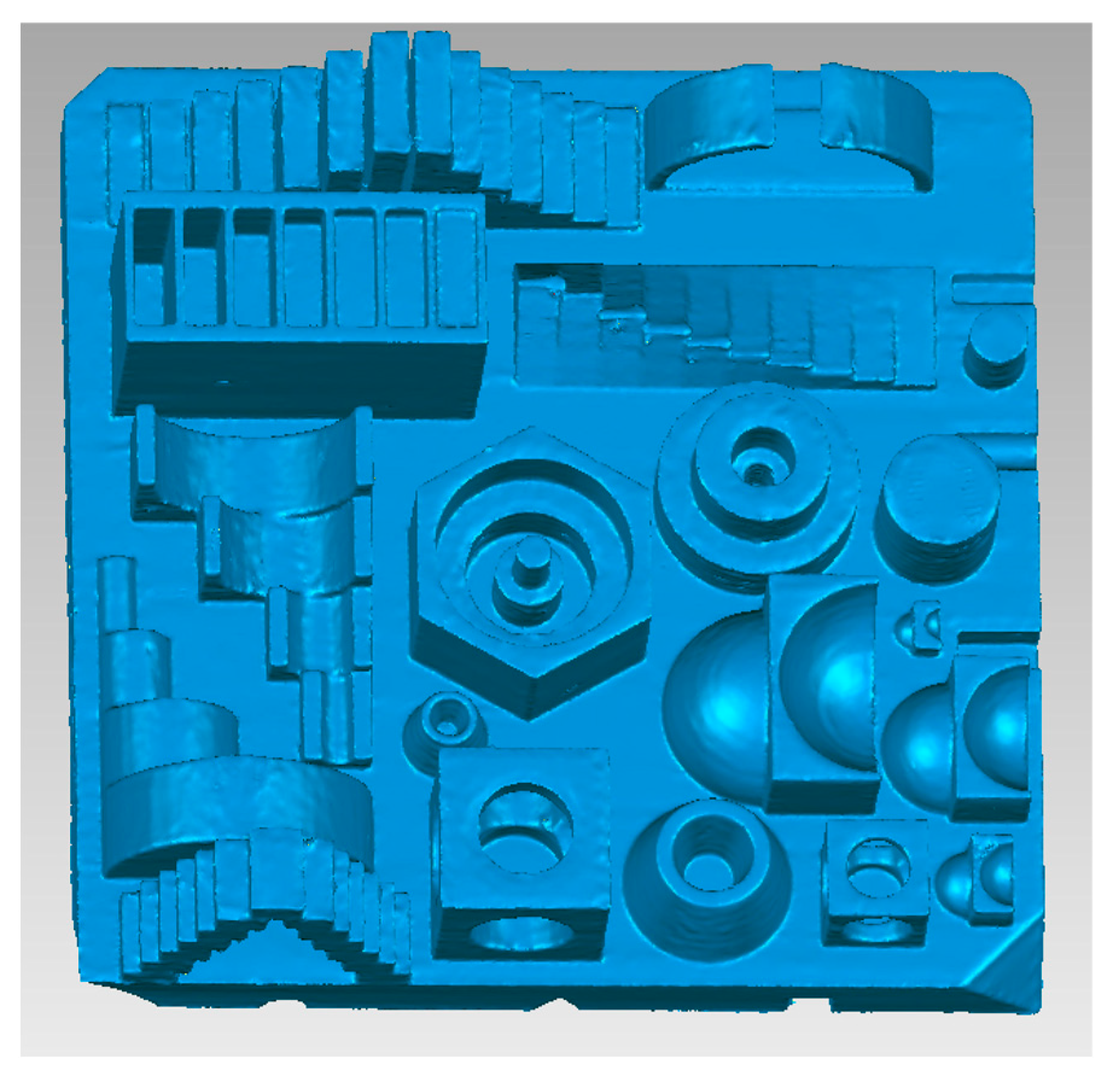


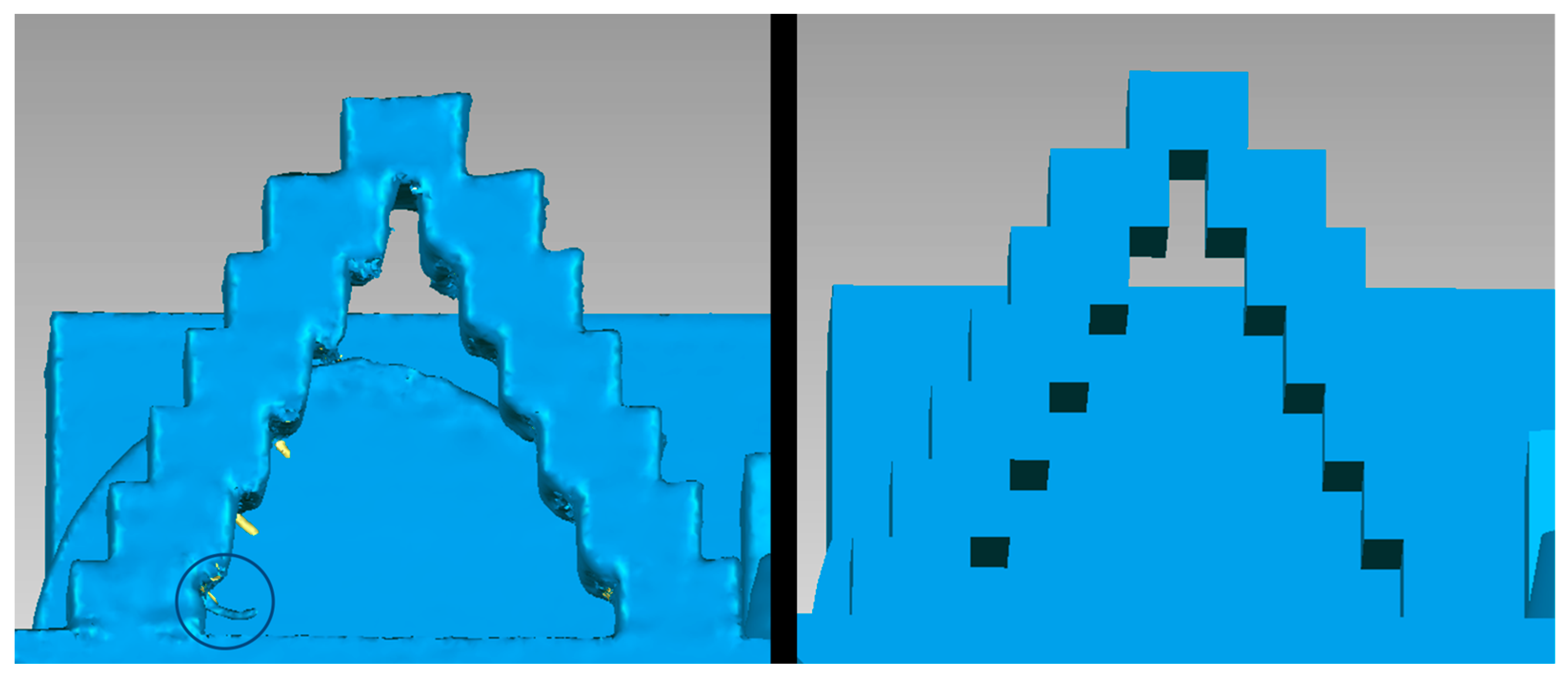
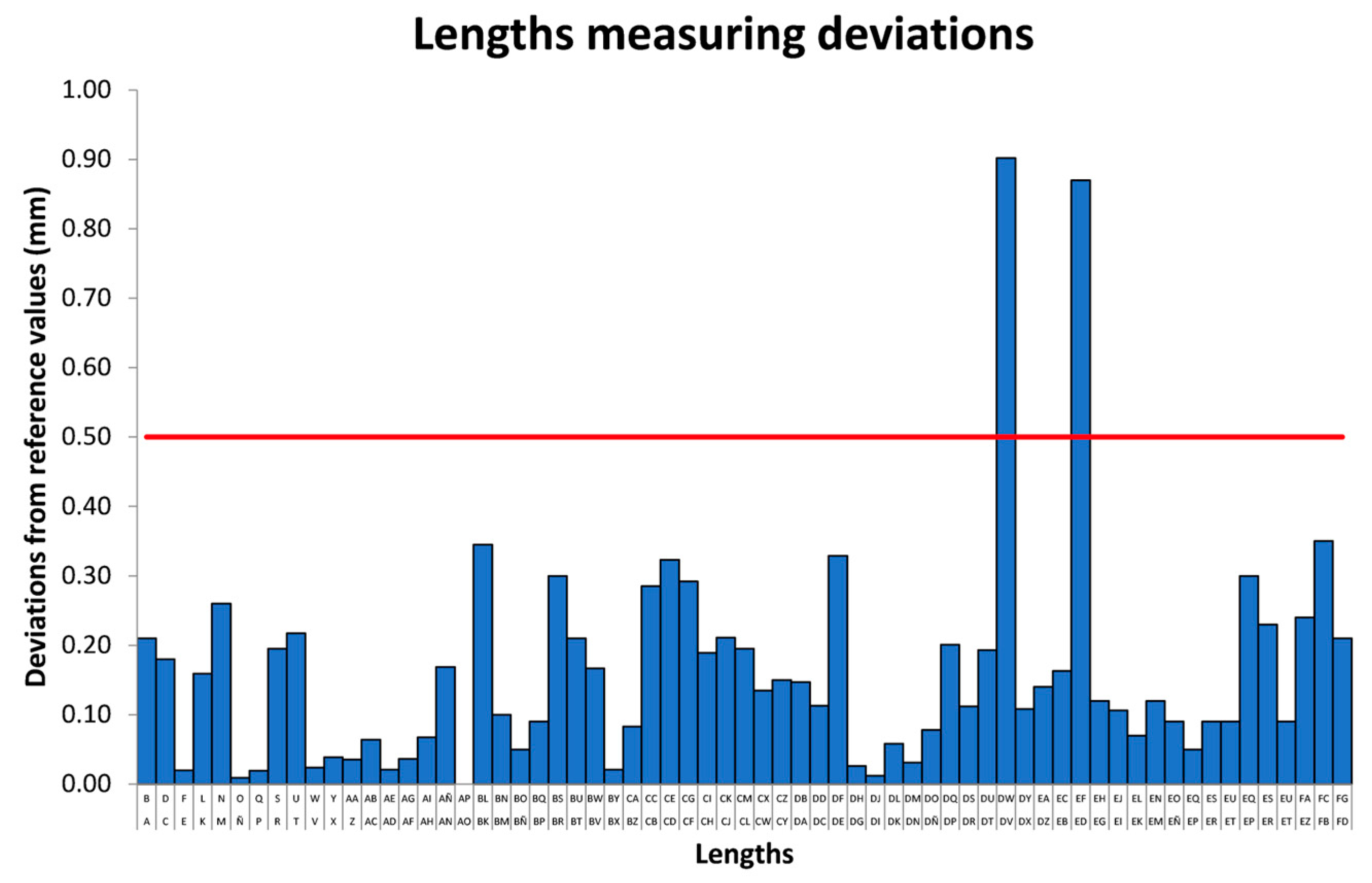
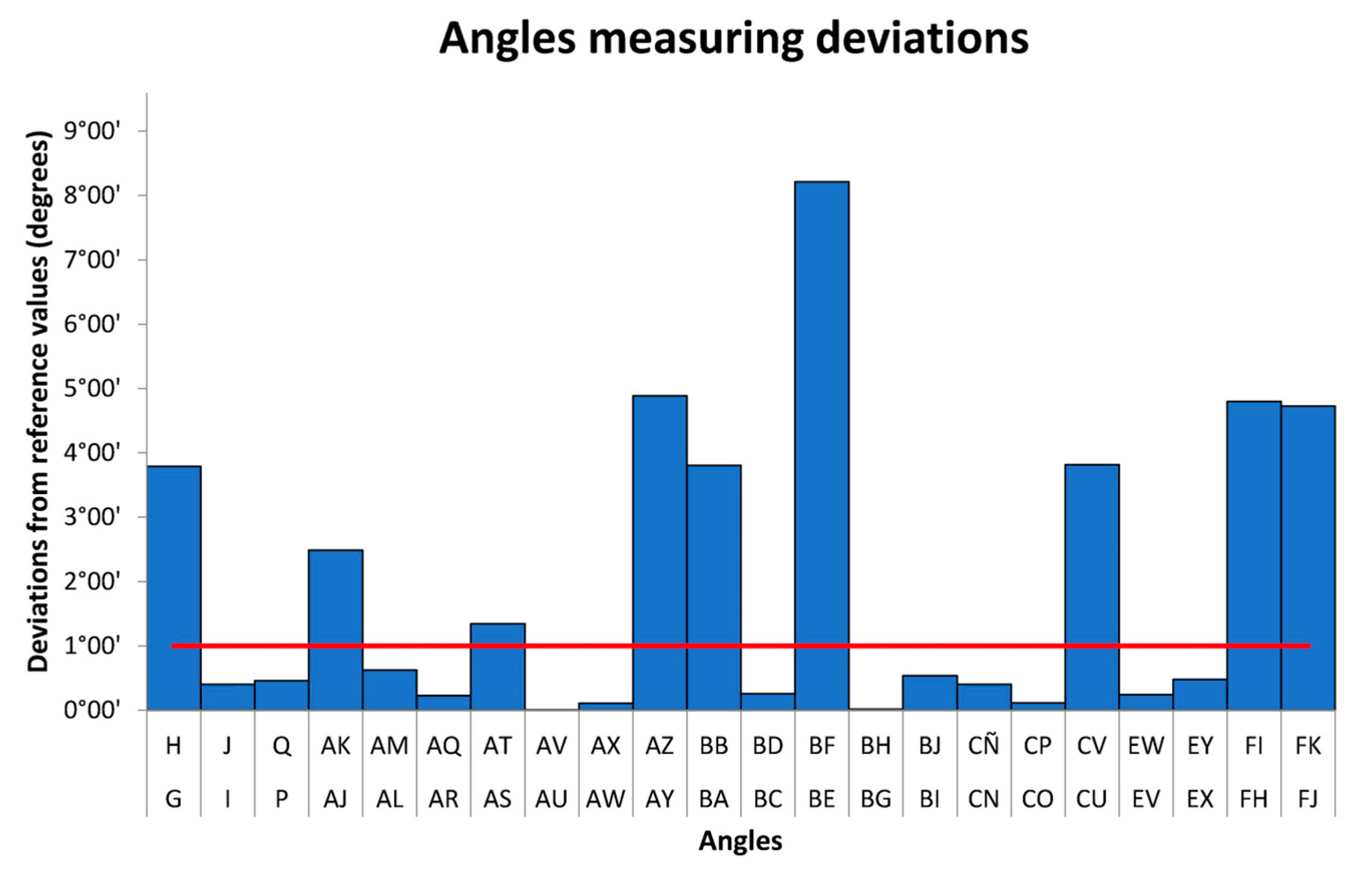
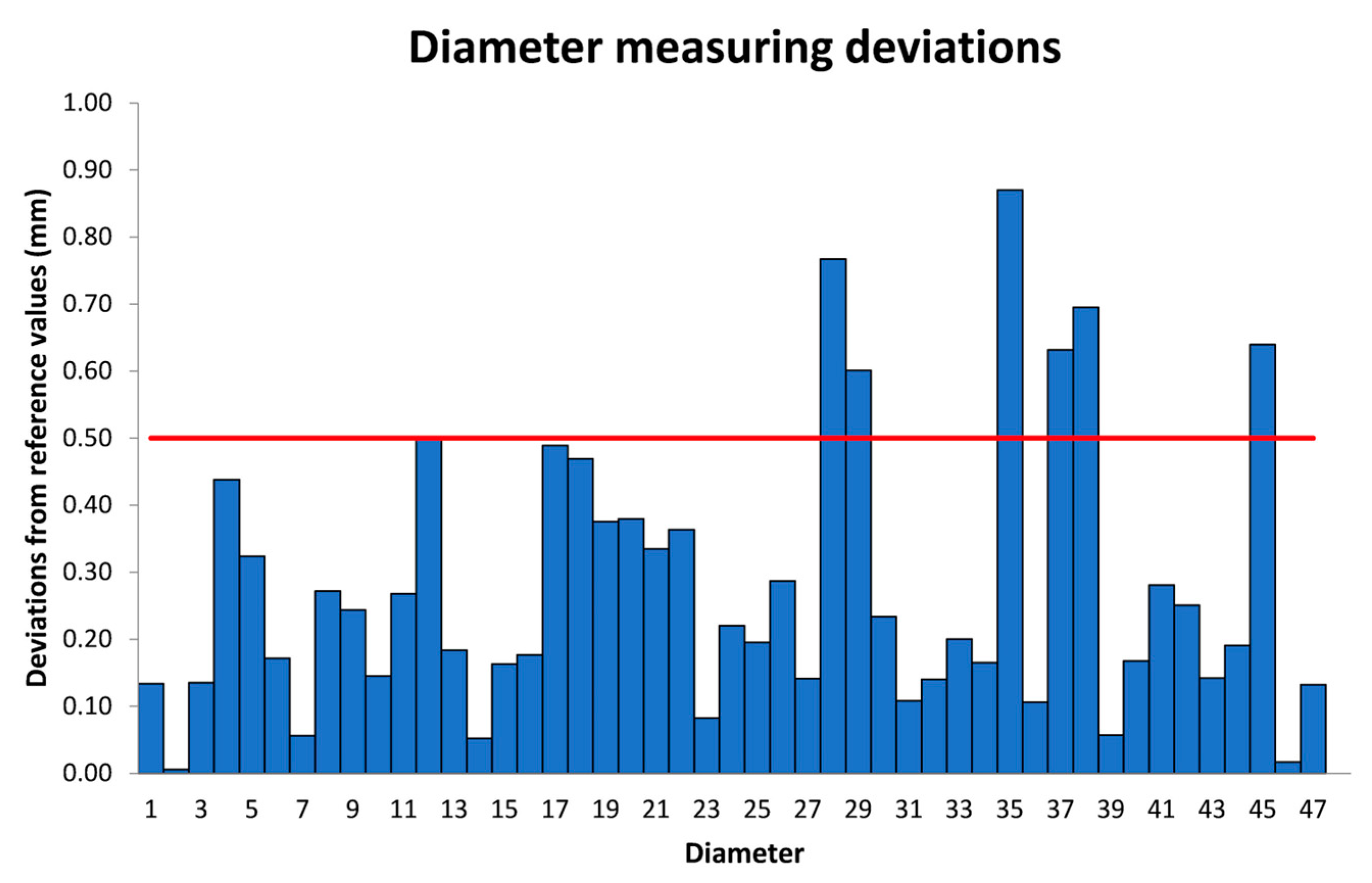
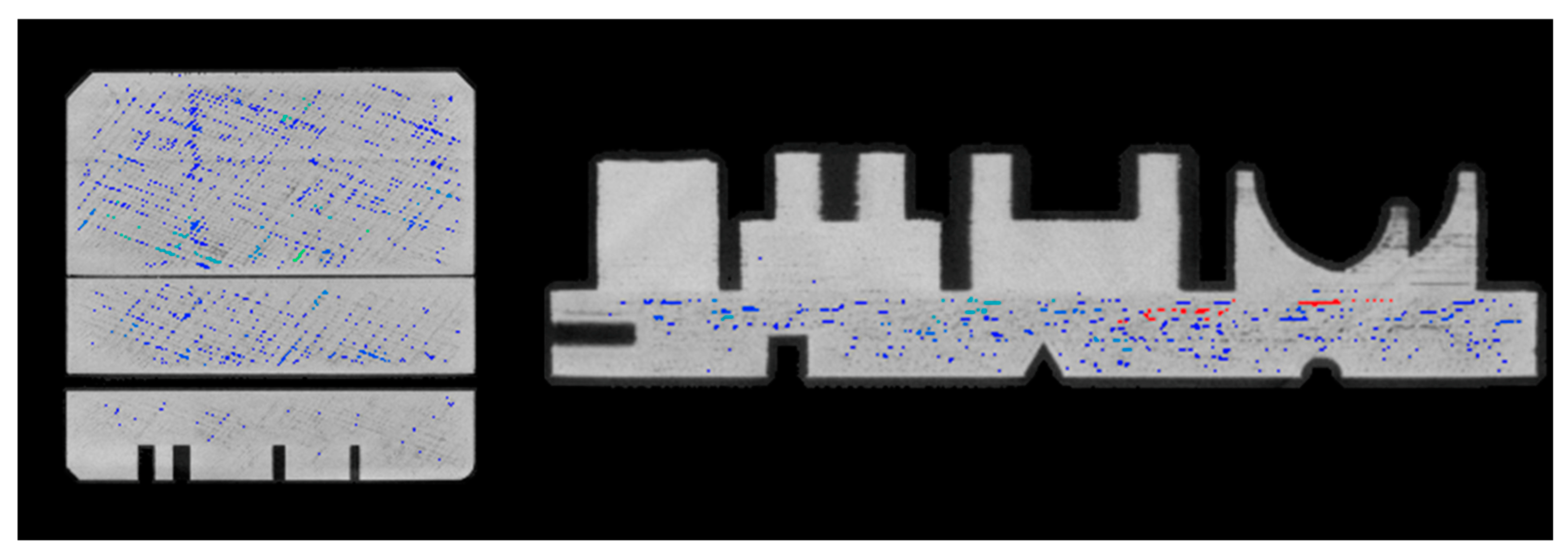

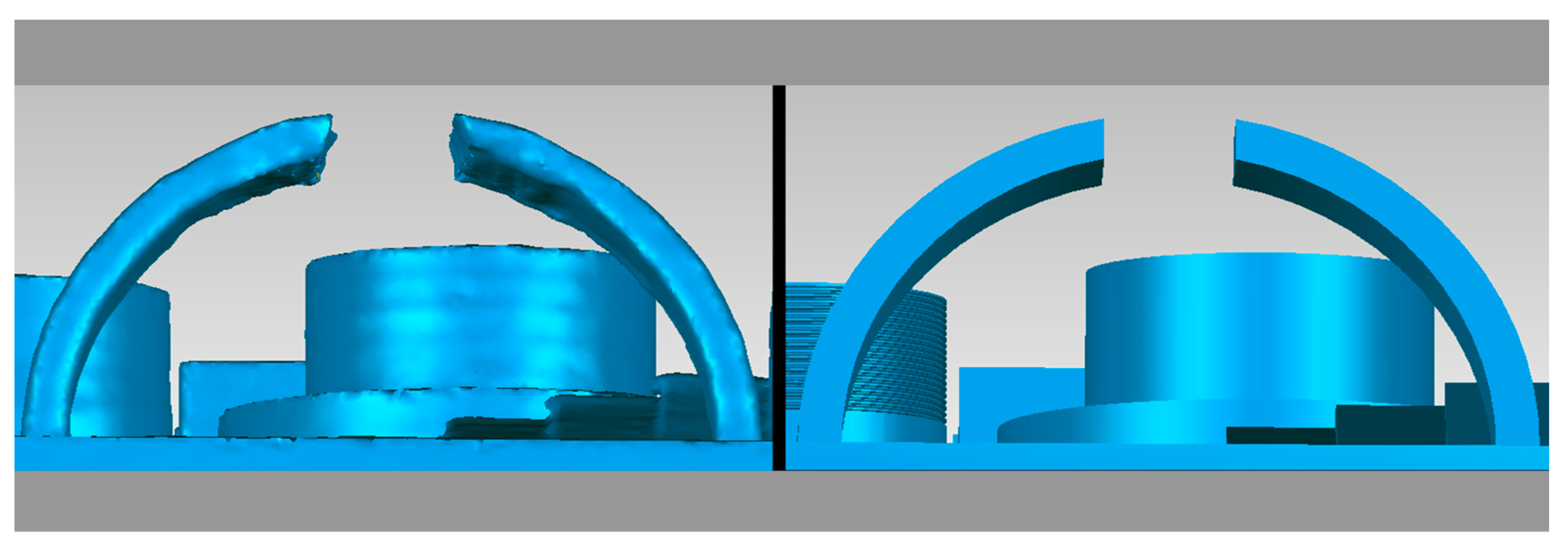
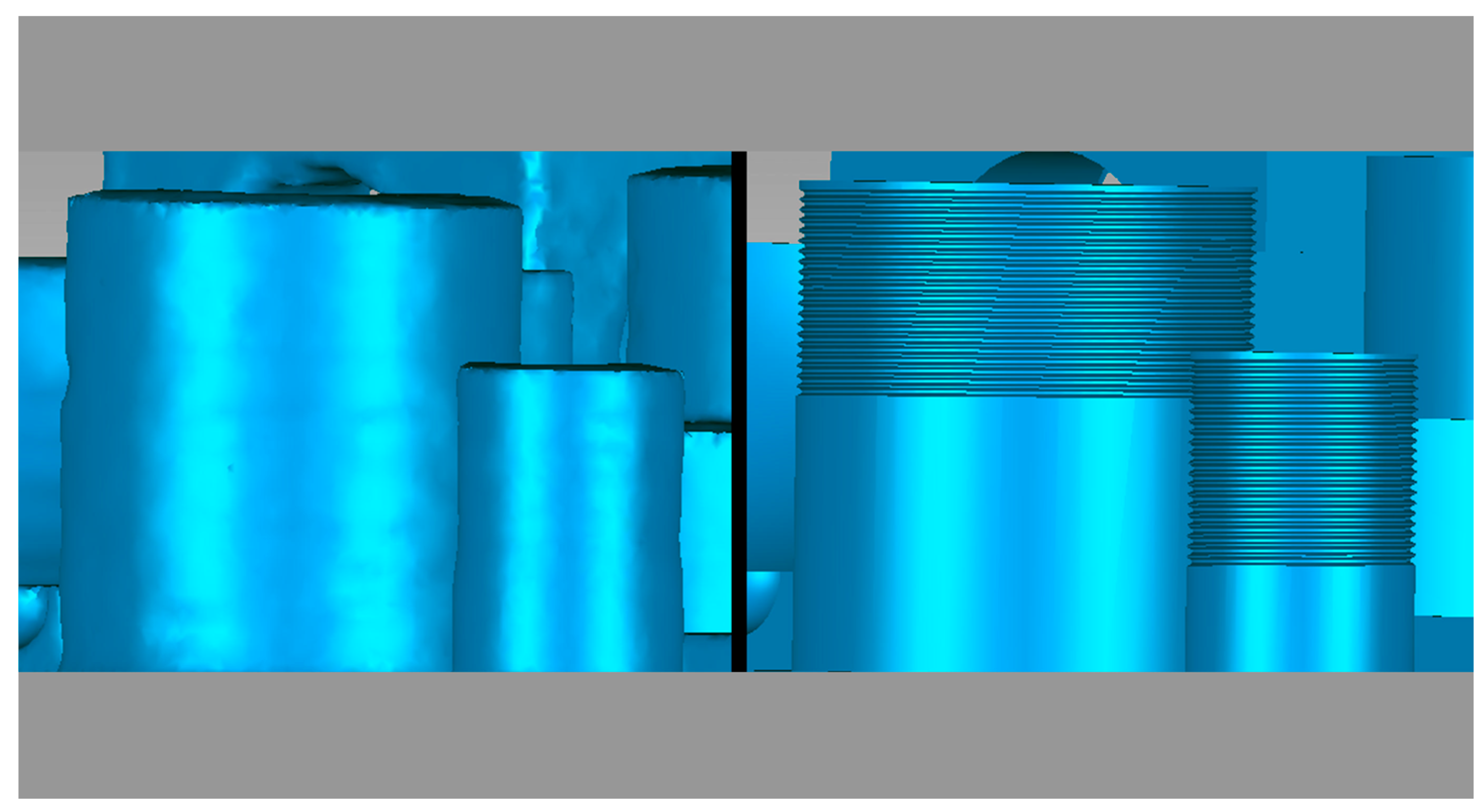
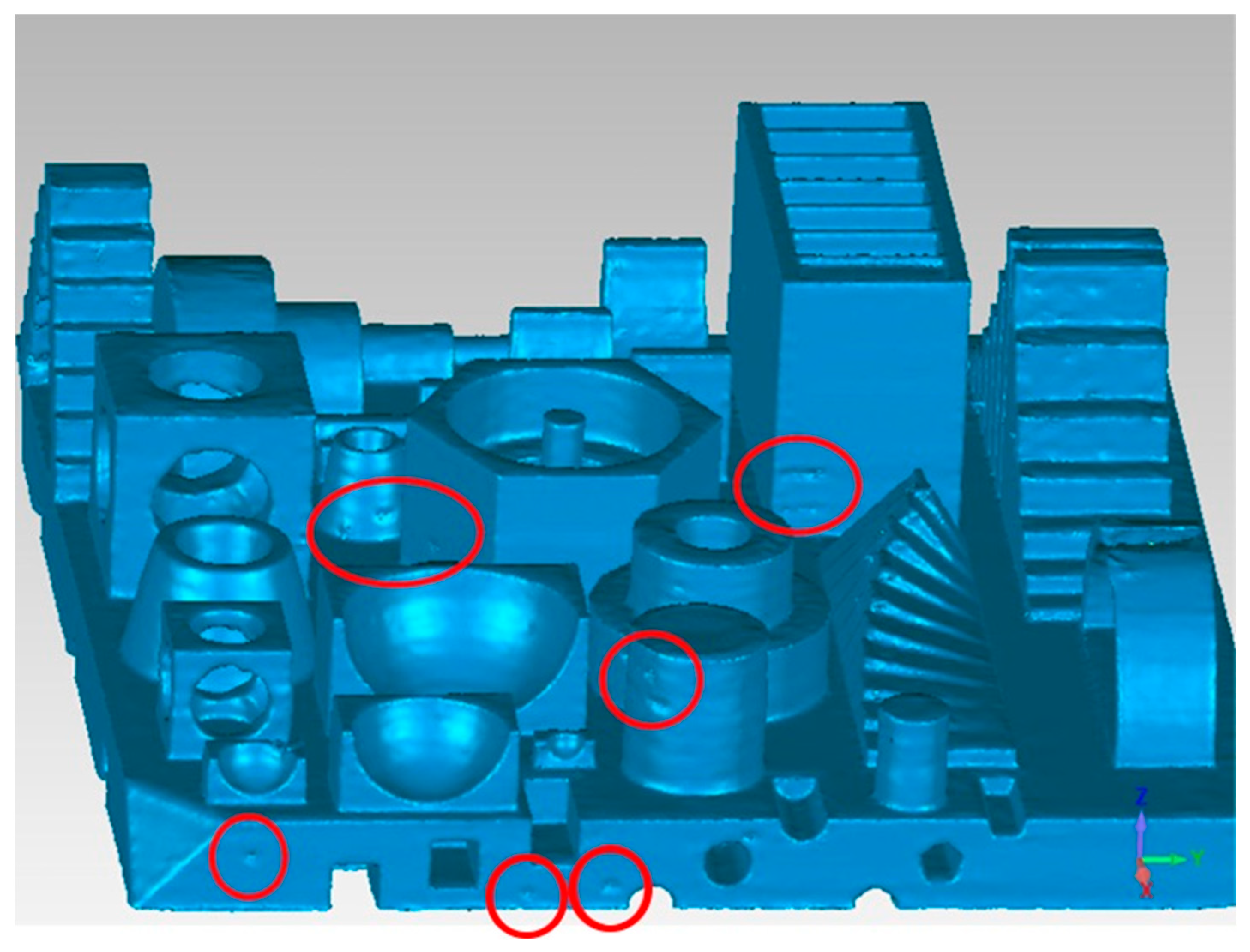
| Industry | Developed |
|---|---|
| Automotive | 644 |
| Chemicals | 520 |
| Building materials | 180 |
| Textiles and Clothing | 112 |
| Pharmaceuticals | 317 |
| Precision Instruments | 185 |
| Machine Tools | 175 |
| Aerospace | 50 |
| Parameter | Magnitude | Reference |
|---|---|---|
| Nozzle diameter | 0.3 mm | [77] |
| Quality | Magnitude | [78,79] |
| Layer height | 0.15 mm | |
| Perimeter | Magnitude | [79,80] |
| Wall thickness | 0.8 mm | |
| Upper/lower thickness | 0.8 mm | |
| Filling | Magnitude | [15,81] |
| Filling density | 100% | |
| Filling pattern | Lines | |
| Material | Magnitude | [82,83] |
| Printing temperature | 215 °C | |
| Printing bed temperature | 60 °C | |
| Diameter | 1.75 mm | |
| Flow | 100% | |
| Retraction | Enabled | |
| Speed | Magnitude | [15,79] |
| Printing speed | 60 mm/s | |
| Travel speed | 120 mm/s | |
| Cooling | Magnitude | [84] |
| Print cooling | Activate | |
| Support | Magnitude | [85,86,87,88] |
| Generate support | Active for -Z | |
| Support placement | Everywhere | |
| Adhesion of the printing plate | [77,85,86,89] | |
| Type of adhesion | Border | |
| Edge width | 8.00 mm |
| Feature | Technical Data |
|---|---|
| Print size | 330 × 240 × 300 mm |
| Feeding | 100–240 VAC, 50–60 Hz |
| Software | Ultimaker Cura |
| XYZ Resolution | 6.9, 6.9, 2.5 micras |
| Nozzle diameter | 0.25 |
| Nozzle temperature | 180–260 °C |
| Bed temperature | 20–110 °C |
| Printing speed | <24 mm3/s |
| Characteristics | Technical Data |
|---|---|
| Appearance | Filament |
| Color | White |
| Ignition temperature | 388 °C |
| Thermal decomposition | 250 °C |
| Melting point/melting range | 145–160 °C |
| Density | 1.24 g/cm3 |
| Feature | Geometry |
|---|---|
| Flat base | Quadrangular base, set of blocks, pyramid overhang. |
| Prisms | Base quadrangular groove, base quadrangular groove, perforated cube, ladder, grooves. |
| Cylindrical drilling | Coaxial cylinders, base pass-through drilling, base drilling, and cube-drills. |
| Sphere | Set of spheres. |
| Solid cylinder | Concave semi-cylinders. |
| Hollow cylinder | Convex semi-cylinders, cantilevered arch. |
| Cone | Truncated cones. |
| Angled surfaces | Truncated cones, triangular perforations, staircases, inclined planes, and pyramids of blocks. |
| Magnitude | Feature | Description | Reference Value |
|---|---|---|---|
| Long | Plane A to Plane B | Distance from Plane A to Plane B (Plane A is parallel and opposite to Plane B) | 13 + 0.5 mm |
Disclaimer/Publisher’s Note: The statements, opinions and data contained in all publications are solely those of the individual author(s) and contributor(s) and not of MDPI and/or the editor(s). MDPI and/or the editor(s) disclaim responsibility for any injury to people or property resulting from any ideas, methods, instructions or products referred to in the content. |
© 2023 by the authors. Licensee MDPI, Basel, Switzerland. This article is an open access article distributed under the terms and conditions of the Creative Commons Attribution (CC BY) license (https://creativecommons.org/licenses/by/4.0/).
Share and Cite
Aguilar-Duque, J.I.; Ontiveros, S.; Baez-Lopez, Y.; Juárez-Luna, V.M.; Brau-Avila, A.; Tlapa, D. Structural and Dimensional Analysis by Computed Tomography of a Multi Geometric Template Manufactured by Fused Deposition Modeling. Micromachines 2023, 14, 1934. https://doi.org/10.3390/mi14101934
Aguilar-Duque JI, Ontiveros S, Baez-Lopez Y, Juárez-Luna VM, Brau-Avila A, Tlapa D. Structural and Dimensional Analysis by Computed Tomography of a Multi Geometric Template Manufactured by Fused Deposition Modeling. Micromachines. 2023; 14(10):1934. https://doi.org/10.3390/mi14101934
Chicago/Turabian StyleAguilar-Duque, Julian I., Sinue Ontiveros, Yolanda Baez-Lopez, Victor Manuel Juárez-Luna, Agustín Brau-Avila, and Diego Tlapa. 2023. "Structural and Dimensional Analysis by Computed Tomography of a Multi Geometric Template Manufactured by Fused Deposition Modeling" Micromachines 14, no. 10: 1934. https://doi.org/10.3390/mi14101934






